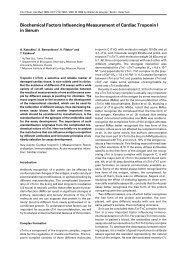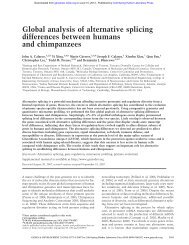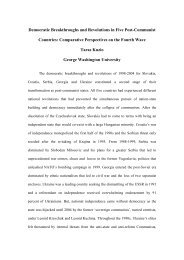The New Human Tissue Kallikrein Gene Family - Endocrine Reviews
The New Human Tissue Kallikrein Gene Family - Endocrine Reviews
The New Human Tissue Kallikrein Gene Family - Endocrine Reviews
Create successful ePaper yourself
Turn your PDF publications into a flip-book with our unique Google optimized e-Paper software.
192 YOUSEF AND DIAMANDIS Vol. 22, No. 2TABLE 4. Proteins encoded by kallikrein genes<strong>Kallikrein</strong>Length of preproenzymeLength of signalpeptide (cleavage) aLength ofactivation peptide/cleavage aLength ofmature proteinAmino acid ofsubstrate binding pocketReferencehK1 262 17 (A 2 A) 7 (R 2 I) 238 D 34, 35, 43, 49hK2 261 17 (A 2 V) 7 (R 2 I) 237 D 43, 49, 94hK3 261 17 (A 2 A) 7 (R 2 I) 237 S 43, 49, 95–97hK4 254 26 (G 2 S) 4 (Q 2 I) 224 D 70–72hK5 293 29 (A 2 N) 37 (R 2 I) 227 D 80, 81hK6 244 16 (A 2 E) 5 (K 2 L) 223 D 73, 74, 82, 83hK7 253 22 (G 2 E) 7 (K 2 I) 224 N 84, 85, 107hK8 260 28 (A 2 Q) 4 (K 2 V) 228 D 86, 98hK9 251 19 (A 2 D) 3 (R 2 A) 229 G 67hK10 276 33 (A 2 A) 9 (R 2 L) 234 D 76hK11 250 18 (G 2 E) 3 (R 2 I) 229 D 88, 89, 100hK12 248 17 (A 2 A) 4 (K 2 I) 227 D 77hK13 277 20 (S 2 Q) 5 (K 2 V) 252 D 78hK14 251 18 (S 2 Q) 6 (K 2 I) 227 D 90hK15 256 16 (A 2 Q) 5 (K 2 L) 235 E 69a Most are predicted; need verification by experiment.TABLE 5. Hormonal regulation of human kallikreins<strong>Gene</strong> Systems tested HREs a Functionally tested? Up-regulating hormone(s) ReferenceKLK1 In vivo humans, rodents Putative No Uncertain 19KLK2 LNCaP; BT-474, T-47D Yes (2 AREs) Yes Androgen, progestin 134–137KLK3 LNCaP, BT-474, T-47D Yes (3 AREs) Yes Androgen, progestin 118–125133–134KLK4 LNCaP; BT-474 Putative (AREs) No Androgen, progestin 70–72KLK5 BT-474 NS (not studied) Estrogen, progestin androgen 80KLK6 BT-474 NS Estrogen, progestin androgen 83KLK7 BT-474 NS Estrogen glucocorticoid 85KLK8 Not studied KLK9 BT-474 NS Estrogen, progestin androgen 67KLK10 BT-474 Not found Estrogen androgen progestin 140KLK11 BT-474 NS Estrogen, glucocorticoid 89KLK12 LNCaP, BT-474, T-47D NS Androgen, progestin estrogen but in BT-474, 77estrogen androgen progestinKLK13 BT-474 NS Androgen, progestin estrogen 78KLK14 Not studiedKLK15 LNCaP No Androgen progestin, estrogen 69LNCaP, Prostate carcinoma cell line; BT-474, T-47D, breast carcinoma cell lines.a Hormone response elements.cance already exist (43, 47–49, 152–158). It should be emphasizedthat, in general, the putative proteins encoded bythese variant transcripts have not been isolated. By openreading frame analysis, it has been predicted that most transcriptswill produce truncated proteins due to frameshiftsoriginating from deleted exons. More details on these varianttranscripts and the predicted encoded proteins can be foundin the literature cited in Table 7 (34, 69, 77, 78, 86, 94, 96–98,137, 159–165).IX. Association of <strong>Kallikrein</strong>s with <strong>Human</strong> DiseasesAs already mentioned, the only enzyme with efficientkininogenase activity, among the human kallikrein familymembers, is hK1. <strong>The</strong> biological effects of this enzyme, andof plasma kallikrein, are mediated mainly by kinin release.Kinin binds to specific G protein-coupled cell surface receptorsto mediate diverse biological functions. <strong>The</strong> kallikreinkininsystem is involved in many disease processes, includinginflammation (9), hypertension (166), renal disease (167,168), pancreatitis (169), and cancer (170–174). A recent booksummarizes elegantly the physiology, molecular biology,and pathophysiology of the kallikrein-kinin system and itsassociation to various disease processes (175).Among all other kallikreins, the best studied, by far, is PSA(hK3) and especially, its application to prostate cancer diagnostics.A comprehensive volume on PSA as a tumormarker has been recently published (176). <strong>The</strong> extensive literatureon PSA and prostate cancer does not warrant furtherdiscussion in this review.Although PSA concentration is generally elevated in theserum of prostate cancer patients, one less known and usuallynot well understood finding is PSA down-regulation inprostate cancer tissue, in comparison to normal or hyperplasticprostatic tissues (177–182). Furthermore, it has beendemonstrated that lower tissue PSA concentration is associatedwith more aggressive forms of prostate cancer (182,183). <strong>The</strong>se data agree with those published for breast cancer,where it was found that PSA is down-regulated in cancerousbreast tissues, in comparison to normal or hyperplastic breasttissues, and in more aggressive forms of breast cancer. Patientswith PSA-positive tumors usually have earlier diseasestage, live longer, and relapse less frequently (184–186). Furthermore,it was found that lower PSA levels in nipple as-
















